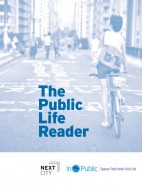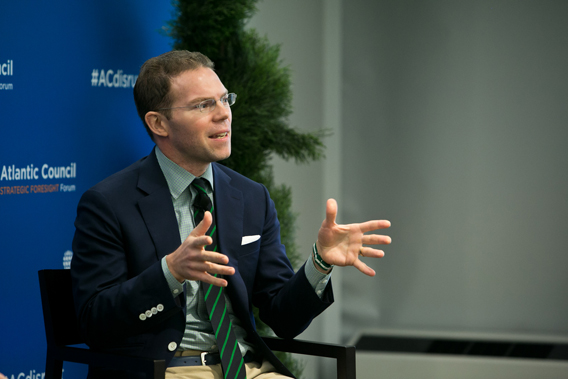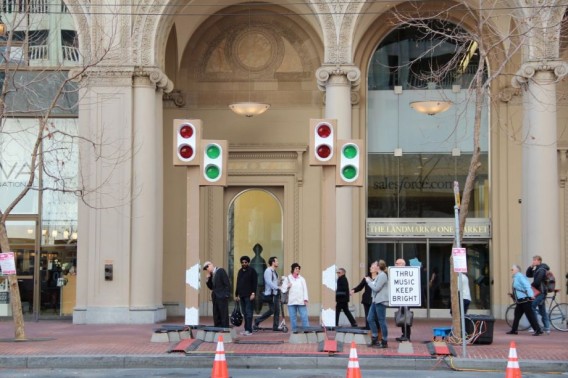














June 16, 2015 | permalink
My friends at Speakers Spotlight have created this four-minute supercut stitching together my appearances studded throughout the documentary Mankind from Space, which aired on Discovery Canada and National Geographic International in May, and is coming to PBS later this year. Click on the video above for my portentous ruminations on cities, air routes, and globalization… you know, the usual.
June 16, 2015 | permalink

The folks at Next City have published The Public Life Reader, a free e-book collecting six months of essays about designing public space for maximum personal interactions. I’m honored that my report on how mobile dating apps are changing their users’ perceptions of the city was included in the mix. Please download and read the entire thing.
May 21, 2015 | permalink

(Originally published at Next City on May 17, 2015.)
If the critics are any indication, MoMA’s architecture exhibition, “Uneven Growth: Tactical Urbanisms for Expanding Megacities,” won’t be missed when it closes next week on May 25.
New York’s Justin Davidson panned the show in November before it even opened , followed by Tactical Urbanism co-author Mike Lydon’s two-part critique disputing its entire premise, including the title. The final insult arrived in March when Harvard’s Neil Brenner demolished the show’s assumptions on MoMA’s own website. But if you need a reason to see “Uneven Growth” before it’s gone, perhaps the best is becoming better acquainted with the work of Brenner’s favorite team, the Mumbai-based “urbanologists” of URBZ.
Practically speaking, URBZ is a research, design, and activist group led by Matias Echanove and Rahul Srivastava, who have spent the last six years working in Dharavi, the world’s most infamous slum. They refuse to call it that, however, and so do its residents. The pair titled their 2014 e-book “The Slum Outside” as a nod to this disavowal – the Dharavi they know is a middle-class neighborhood. “The slum” is always outside, somewhere else.
The slum, of course, is the hottest button in urbanism. Beneath the cliché that half the world’s population lives in cities – and that urban populations will double by 2050 – is the fact that only bottom-up informal settlements, or slums, can absorb several billion new residents in the timeframe. The debate is whether these places are engines of hope and upward mobility (i.e. the prosperity gospel of Stewart Brand , Ed Glaeser , and, to a lesser extent, Robert Neuwirth) or places where relentless entrepreneurialism belies the hopelessness of ever escaping (a point made in various polemics by Mike Davis, George Packer, and Daniel Brook).
May 05, 2015 | permalink
On Sunday, May 3, Discovery Canada aired the premiere of “Mankind from Space,” a two-hour documentary on the man-made networks binding humanity into a global civilization. The short clip above includes me holding forth on transportation. More to come.
April 30, 2015 | permalink
(“Access,” a magazine published by FedEx Corporation to advance its interests in increasing connectivity and trade, recently interviewed me about the future of connected transportation.)
Greg Lindsay gets around, and he wants us all to get around better than we do. An urbanist and widely published journalist who’s a leading voice in next-generation, digitally driven mobility, Lindsay can point to a recent explosion of new companies and new ideas that are challenging our conceptions of human transport: sharing-economy models (Uber, Lyft, Car2Go, etc.), transit-connecting apps, autonomous and semi-autonomous cars, and global sustainable transport projects such as the World Resources Institute’s EMBARQ initiative. Lindsay is co-director of the World Policy Institute’s Emergent Cities Project and a visiting scholar at New York University’s Rudin Center for Transportation Policy and Management. We asked him about the ways the digital transformation of transportation can boost human productivity and connectivity.
ARE THERE ANY AREAS WHERE LARGE-SCALE DIGITALLY CONNECTED TRANSPORTATION IS HAPPENING?
Uber and Lyft have already proven you can build a globally scalable system, at least when it comes to cars. But the real transformation will come from integrating all or nearly all modes of transportation, including trains, buses and bicycles. No one has built such a system yet, but there are some interesting hints of what it might look like.
One hint is the advent of apps like RideScout and Citymapper, which use open transit data to offer users a choice of which mode to take. How do I get from A to B, you might ask? Well, here’s how long it would take to drive, versus bike to the nearest train stop, versus taking a taxi, and so on. Once you have that, the next step is to build an app that can offer a single fare across any of those nodes and guarantee the schedules mesh.
An early example of this is Shift, in Las Vegas. It’s a monthly membership service combining car-sharing and bike-sharing within a single app, assigning vehicles as necessary depending on where you want to go. Another hint is Helsinki’s Kutsuplus, which is an on-demand bus service that plots its routes depending on where today’s passengers want to go. The city has an even more ambitious plan to create a citywide system by 2025 that seamlessly meshes public transit, private transit and bike-sharing.
WHAT KINDS OF ECONOMIC BENEFITS COULD SUCH TRANSPORTATION SYSTEMS PROVIDE?
They’d be profound. Cities’ job and housing markets are largely shaped by transportation. I live in Queens, New York, and my neighborhood has any number of informal workarounds – such as taxis that double as quasi-legal jitneys each morning – to make up for a lack of formal transit options.
But what if public transportation were free? That’s what Tallinn, Estonia, has done. It was originally done to reduce traffic congestion, but the early data suggests the biggest beneficiaries are the poorest and most marginalized residents, who also happen to suffer from the least accessibility. Free transit means better connections to potential employment – and hopefully better integration with society.
WHAT ARE THE CHALLENGES IN CREATING DIGITALLY DRIVEN MOBILITY?
The first challenge is updating and coordinating outdated transit information systems. The second is the political battle over whether transportation is a public or private good. Uber would rather fight cities trying to regulate rather than working with them to create value. The other challenge is delivering these new services equitably. We can build incredible services, but if we can’t make them affordable or accessible, we’re only hurting the ones who need them most.
WILL THESE INNOVATIONS AND IDEAS WORK OR HAVE ANY APPEAL IN SUBURBAN AND EXURBAN AREAS, AS OPPOSED TO HIGH-DENSITY CITIES?
That’s the $64 billion question, and that’s also why I’m especially interested in the accessibility argument. We’re seeing poorer families and immigrants landing in suburban communities where there is little transit and little or no push to build more. The only way to increase transportation access there – besides just putting more cars on the road – is to create digitally connected transit via options such as minibus services, Uber or something else.
We don’t have a consensus in this country on building more transit infrastructure to solve congestion. So we’ll turn to our smartphones and our bandwidth, which is the one area we all can agree is worthy of investment.
April 23, 2015 | permalink

I’m delighted to announce I’m joining the Atlantic Council as a non-resident senior fellow in the Brent Scowcroft Center on International Security’s Strategic Foresight Initiative. The Council is one of America’s most respected think tanks, founded in 1961 to build cooperation between America and its European allies during the Cold War. Today, SFI acts as the intelligence community’s de facto futurist arm, led by director Matthew Burrows – who previously started and ran the National Intelligence Council’s Strategic Futures Group. He’s written about his time there in his book, The Future, Declassified.
I was fortunate to speak at the Council’s annual Strategic Foresight Forum in 2013 on the challenges and opportunities of mega-urbanization, one of SFI’s key projects (and arguably the most innovative and interdisciplinary in the context of DC politics). I look forward to contributing to that project and wherever else I can be of service. To quote Hunter S. Thompson: “When the going gets weird, the weird turn pro.”
April 23, 2015 | permalink

Last fall, I was interviewed for a documentary titled “Mankind From Space,” a truly big-picture look at the infrastructure making globalization possible. Although American viewers won’t be able to watch it until it airs on PBS sometime in 2016, Canadians will receive a sneak preview on May 3rd, when it airs on Discovery Canada. Due to the vagaries of international DRM, I’m not even able to watch the online trailer, but here’s a description:
From the global perspective of space, MANKIND FROM SPACE reveals the breathtaking extent of hum influence on the world; how we have transformed vast swathes of our planet and produced an interconnected world of extraordinary complexity.
This two-hour special examines seemingly small flashes of innovation in agriculture, commerce, power, transportation, communication and technology that forever changed the course of civilization. These human advances led to the creation of the modern wonders of the world and the development of an intricate web of networks that span the globe and link billions of us together.
Today satellites from space reveal this web of man-made networks that link us globally. Using the latest satellite data and cutting edge CGI technology, MANKIND FROM SPACE, peels back the networks layer by layer, revealing the globally connected society we live in.
Today’s wealth of data also helps us gaze into the future at the new challenges we face in order to survive – feeding and powering our rapidly growing population – and inspires us to pursue bold new innovations that will secure our future on earth.
MANKIND FROM SPACE reveals in stunning new detail how civilization developed, how it functions today and how it will work in the future.
April 23, 2015 | permalink

(Originally published at Next City on April 15, 2015.)
Last Thursday morning, a cohort of visiting government officials, nonprofit founders and advocates for the arts spilled onto San Francisco’s Market Street to discover a hexagonal ping-pong table. To their delight, the table doubled as a virtual jukebox, blasting a repertoire of AC/DC and Stevie Wonder songs as they picked up paddles and began to play. It didn’t take long for a knot of curious onlookers to form, with a few taking seats on wooden stools arrayed around the table. As players tired, they passed their paddles to the next person waiting, and so it went the rest of the day into the night.
Arena/Play, as the installation was called, was one of the hits of last week’s Market Street Prototyping Festival, a three-day trial run of more than 50 projects vying to become permanent additions to the city’s most prominent thoroughfare ahead of its planned reconstruction in 2018. But the jury is literally still out on whether the table answered a deeper question: Does that passing of the paddle from one stranger to another represent the atomic building block of public space and public life – and if so, is it possible to capture these moments and manufacture more of them?
March 24, 2015 | permalink

RIBA Journal – the house magazine of the Royal Institute of British Architects – quoted me in the new issue on the subject of office design:
Meanwhile, the ongoing march of technology will impose new space and infrastructure requirements, enabling offices to function more intelligently, monitoring and controlling functions such as ambient temperature, security systems, lighting, fire and life safety systems intuitively in real time.
Architects will have to adapt to meet the challenges of this brave new world, says Greg Lindsay, a workplace design expert and author: ‘I find it fascinating that there is a litany of business literature about the importance of disruption to working patterns to improve creativity and productivity, by changing teams, altering their food and environment etc, yet we still work in offices that are designed once and typically last 10 years or more without a refresh.’
He adds: ‘Workplace design today reflects the formal hierarchies of how work is supposedly done, yet we know from studies that work actually gets done in an informal, less structured way. The question for architects designing the offices of the future is: how do you do a better job of reflecting that, rather than struggling against it by producing the same pointless buildings over and over again?’
March 19, 2015 | permalink
(On February 20, I participated in the Global Solution Networks Summit in Washington, DC. Launched by the Tapscott Group and based at the University of Toronto’s Martin Prosperity Institute at the Rotman School of Management, GSNs are part of an effort to imagine new models of problem-solving. I was asked to chair the summit’s Cities table, and a summary of our discussion – and proposed GSN for housing – is below. The complete report can be found here.)
By 2025, 60% of the world’s population is expected to be living in cities. Rapid urbanization will cause significant stress on the existing infrastructure and social dynamics of cities. Yet, cities continue to be economic powerhouses–offering jobs and opportunities. In order for the benefits of cities to be maximized, it is vital that solutions are found to problems like urban poverty, pollution, congestion, and exclusion.
The Cities roundtable was facilitated by Greg Lindsay of the World Policy Institute. The group discussed urban issues such as transportation and congestion, lack of cooperation between public and private actors on urban design, austerity measures that have cut public services, and disaster preparedness. The role of major urban groups such as the academic and private sectors was also explored. It was difficult for the group to narrow down a specific problem to tackle as many of the issues are interrelated. Debate ensued about whether it would be valuable to create a meta-network where municipalities could access solutions occurring in other areas, or whether it would be better to start with a test case issue that could be scaled.
Ultimately, the group focused on the issue of affordable housing. Housing sits at the center of a whole host of urban issues, including inequality, austerity, and tenure. Community land trusts (CLTs) were developed in the United States fifty years ago as a citizen- and community-led alternative to government-provided public housing. While CLTs have proven their longevity, they have proven difficult to scale. This is because their principal advantage– sequestering land via the trust to eliminate the volatility of housing price–requires significant up-front costs to acquire land for little return.
SOLUTION: “The Trust Network” would be an operational and delivery network that creates a land trust through collaborative financing. The land held by the trust would be used as collateral to create public spaces and services. Multiple stakeholders would be brought in to take a grassroots approach to developing functional communities within cities.
“While creating such a network would still require large initial investments for land acquisition, it would still be possible to use banked land as extremely conservative collateral to help launch revenue-generating businesses that could finance the operation of the trusts and later acquire more land, thus perpetuating the growth of the network.”
Table participants:
Greg Lindsay, World Policy Institute
Faizal Karmali, Rockefeller
Heather Black, Anomaly
Bridget Roddy, US Department of State
Andy Shaindlin, Alumni Futures
Christopher Vivone, Cisco Systems
Bernhard Ritz, SAP
Nausheen Iqbal, American University

» Folllow me on Twitter.
» Email me.
» See upcoming events.

Greg Lindsay is a generalist, urbanist, futurist, and speaker. He is a non-resident senior fellow of the Arizona State University Threatcasting Lab, a non-resident senior fellow of MIT’s Future Urban Collectives Lab, and a non-resident senior fellow of the Atlantic Council’s Scowcroft Strategy Initiative. He was the founding chief communications officer of Climate Alpha and remains a senior advisor. Previously, he was an urban tech fellow at Cornell Tech’s Jacobs Institute, where he explored the implications of AI and augmented reality at urban scale.

----- | January 22, 2024
The Future of Generative AI in Architecture, Engineering, and Construction
----- | January 1, 2024
----- | August 3, 2023
CityLab | June 12, 2023
Augmented Reality Is Coming for Cities
CityLab | April 25, 2023
The Line Is Blurring Between Remote Workers and Tourists
CityLab | December 7, 2021
The Dark Side of 15-Minute Grocery Delivery
Fast Company | June 2021
Why the Great Lakes need to be the center of our climate strategy
Fast Company | March 2020
How to design a smart city that’s built on empowerment–not corporate surveillance
URBAN-X | December 2019
CityLab | December 10, 2018
The State of Play: Connected Mobility in San Francisco, Boston, and Detroit
Harvard Business Review | September 24, 2018
Why Companies Are Creating Their Own Coworking Spaces
CityLab | July 2018
The State of Play: Connected Mobility + U.S. Cities
Medium | May 1, 2017
Fast Company | January 19, 2017
The Collaboration Software That’s Rejuvenating The Young Global Leaders Of Davos
The Guardian | January 13, 2017
What If Uber Kills Public Transport Instead of Cars
Backchannel | January 4, 2017
The Office of the Future Is… an Office
New Cities Foundation | October 2016
Now Arriving: A Connected Mobility Roadmap for Public Transport
Inc. | October 2016
Why Every Business Should Start in a Co-Working Space
Popular Mechanics | May 11, 2016
Can the World’s Worst Traffic Problem Be Solved?
The New Republic | January/February 2016

January 31, 2024
Unfrozen: Domo Arigatou, “Mike 2.0”
January 22, 2024
The Future of Generative AI in Architecture, Engineering, and Construction
January 18, 2024
The Promise and Perils of the Augmented City
January 13, 2024